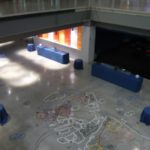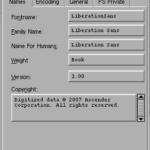DIN 4
Pandora’s Standardised Box
Kommando OSP Pierre and Harrisson spent a few days this February in Berlin to explore the DIN project further.
http://ospublish.constantvzw.org/image/index.php?level=album&id=10
The starting point was that we wanted to design an open format DIN font, based on the original documents stored in the DIN archives.
While encountering books, people, and wandering in our minds away from the DIN font core problematic of how to design such a font, more general (and richer) questions arose: the idea of implementing a “standard”, public purpose fonts, and typographic design done by engineers.
This connects it to another thread going on in OSP: the question of standardised (European) language and its representation.
The DIN Archives
The DIN font is deeply interlaced in German history. It is actually one of its building stones. During this concentrated short stay in Berlin, we opened a lot of boxes, and copyright issues are uncertain…
We were told that there were only few remains of old DIN documents, before 1945, due to the fact that the building (located not far from Postdammer Platz, were fights were particularly intense) was bombed 2 times. Still, there was enough documentation for us to fill holes in the story.
Precious information was as well found in Albert-Jan Pool’s essays published in ENCORE MAGAZINE (No. 13,14,15,17 and 18). It seems that the designer of the massively used “FF DIN”, commissioned and distributed by FontShop, is currently documenting a research that will eventually lead to an extention of the FF family. This study left us with a lot of questions. For example, in 1949, the DDR started their own standard institute, written T (I don’t understand?) and re-taking the DIN number after (I don’t understand?), It seems there has been contact between the institutes. For that reason, an East German version of the DIN font was developed, but what are the rights for this?
DIN rights are not clear to us. We thought it was public domain, but it seems there is a misunderstanding on terms – even if this would logical for a standardisation to spread. We bought 2 sheets of DIN font specification, but we are not sure what we have the rights on with those sheets: the rights to use the font? Access to the know how? Those questions were raised after our RAID visit to the very interesting and wealthy DIN Museum, where everything is DIN, from staples (DIN 1) to coffee cups or… schnaps!
By the way, what used to be the DIN library, has been transformed into a Print On Demand workshop.
Engineer fonts
Encountering the question of standardisation of typography, we couldn’t ignore the proposals of other countries in their efforts to homogenize systems such as highway signage or normalised national industry references.
This lead us to “National Fonts”, and more specifically to signalisation fonts used across Europe. It is amazing to see that the field of road signalisation is often were typography and engineers meet:
We are looking for infos about Swiss and Belgian “Alphabet” 1 to 6 current highway signalisation font, apparently designed by the American 3M company, and imported in Europe via the Marshall Plan.
Seeing strong simultaneities between Bauhaus fonts [what fonts?] and the 3M version, we would like to know if there is any relation between them: is this font the result of engineer’s mind or was it developed by an expatriated Bauhaus student working in the US?
We are looking forward for infos about a Polish roadsigns font, and this we might make the main subject of our next workshop we’ll hopefully set in May, in Wroclaw, Silesia, Poland at the occasion of the “Libre Graphics Meeting 2008” .
Alexander Negrelli showed us a book by a letter painter from 1942 were all fonts, fraktur as well, are structured from a grid. Even the strangest fonts are qualified under a serial number (picture).
The destiny of east German fonts is related as well to this subject.
“Actually, in the strict sense of socialist thought and GDR tradition, the typefaces belong to the people and shouldn’t belong to any individual person.”
Extract from interview of Karl-Heinz Lange, major font designer of VEB Typoart
http://pingmag.jp/2007/10/05/veb-typoart-the-east-german-type-betriebsstatte/
Fonts in the DDR were designed for a central company, apparently in Dresden – VEB Typoart. All the rights seems to be attributed to this Konglomerat. In 1989, after the Wall fell, those fonts were bought with the company, with the building… in a solid state investment. The companies were bought and re-bought until Mr X. got hold of it. Soon after the deal, Mr X had trouble with justice for fraud, and he flew away. No one knows now where the owner of the entire patrimony of former-DDR fonts is right now.
http://en.wikipedia.org/wiki/VEB_Typoart
The Maxima font is currently owned by URW++.
Some of Berlins’ public signage was digitalised by FontShop:
FF City Street Type
The thing is that it seems that there are 2 societies from the city doing signages, from the previous east and west part. Those 2 workshops are still in use, but not with exactly the same specifications, thanks to old systems of reproduction such as silkscreen.
To be continued!
Thanks to:
Raoul Sanders for the research-in-progress
Alexander Negrelli for helping us and sharing with us fleah market typographic treasures.
Arnaud Robin for his hospitality, music and coffe support.
Frederik Schikowski for his open ears.
The DIN Institute: Mr. Peter Anthony and the Permanent Exhibition Crew for their serviceability and kindness.
We hope to continue collaborating with all of them






6 Comments ↓
1. Todd Stackhouse
Apr 15, 2008 at 8:05 pm
[quote]For example, in 1949, the DDR started their own standard institute, written T (I don’t understand?) [/quote]
…that was TGL (I don’t know what the initials actually stood for). I used to work in TV/radio repair, and once actually worked on a radio chassis that was built in the DDR (very unusual to see such a thing in the USA, to say the least!). Many of the components carried a ‘TGL xxxx’ number that was, of course, reminiscent of the ‘DIN xxxx’ numbers I had been used to seeing on components in West German radios.
2. Pierre Huyghebaert
Apr 16, 2008 at 12:21 am
Thanks for the precision, we will use it later! When radio meet typography…
3. Raoul
Apr 17, 2008 at 1:08 pm
TGL means “Technische Normen, Gütervorschriften und Lieferbedingungen”
(Technical Norms, regulation for goods and delivery conditions [free translation])
4. Raoul
Apr 18, 2008 at 9:46 pm
about the history of the VEB Typoart I found an article about the Leipzig Typo Days 2005
http://www.typeforum.de/modules.php?op=modload&name=News&file=article&thold=-1&mode=flat&order=0&sid=314
[i translate some extracts:]
After 1989 the VEB turned into the Toypoart GmbH. In may 1991 the Typoart GmbH was merged with the HL-Computer, West-Berlin (the company of the new owner (Karl Holzer)). Soon it was obvious that didn’t (could) estimate the value of his new property. He was more interested
in the facilities than in the maintainance of the (type)production. Later the company has to file for insolvency and Mr. Holzer, debt-ridden, disappeared untraceable. With him all right gone underground and regarded as lost.
Aftermath the stocks of the VEB Typoart were destroyed. Only some parts were saved by former employees.
Mr. Manfred Richter (former VEB Typoart, now Typostudio SchumacherGebler) reported, that a small part of the fonts were digitalized and saved on tapes and 5 1/4” discs. Toypoart had developped an own format and it’s unknown, if it could be converted to a corrent file format. He also metioned that a part of this digitalized data is located in Leipzig (but where exactly? Museum für Druckkunst, HGB?).
5. .:: DiseñoLibre.ORG ::. » LGM 2008: Open Source Publishing
Jul 19, 2008 at 11:02 am
[…] OSP no se limita al blogging, organizan sus ‘print party’, dan charlas y conferencias, investigan y diseñan, siempre en el contexto de la filosofia FLOSS. Destacan en su blog varias […]
6. Typosphère.fr | Open Source Publishing à Beaubourg
Mar 18, 2009 at 5:18 pm
[…] d’infos sur le projet DIN 4 sur cette page de leur […]